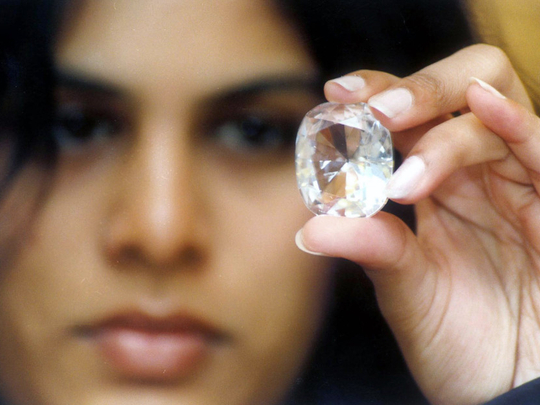
Since the Koh-i-Noor, or Mountain of Light, diamond was mined in India during the middle ages, maharajahs, shahs and princes have fought to possess it. The size of a hen’s egg, it was of inestimable value. Nevertheless, an 18th-century Afghan queen, Wufa Begum, did her best to describe its worth: “If a strong man were to throw four stones, one north, one south, one east, one west, and a fifth stone up into the air, and if the space between them were to be filled with gold, all would not equal the value of the Koh-i-Noor.”
The Koh-i-Noor has belonged to the British since 1849. It sits in the crown of the Queen consort and presumably if Charles becomes king, Camilla will wear it. The diamond was last seen in public on the coffin of the Queen Mother in 2002, but visitors from the Indian subcontinent have been hissing at it at the Tower of London for years.
Recently a British-trained barrister, Javed Iqbal Jaffry, became the latest in a long line trying to prise the rock from the crown. He wrote 786 letters to the Queen and Pakistani government before a judge finally accepted his petition. He is now going to fight to get the gem sent “home” to Pakistan, insisting that the British took it from Lahore unlawfully. “Grabbing and snatching it was a private, illegal act which is justified by no law or ethics,” wrote Jaffry. “A wrong is a wrong. It does not become righteous or right by passage of time or even acquiescence.”
I agree with the argument. But I don’t fancy his chances.
Last year a consortium of Bollywood stars and Mumbai businessmen demanded the Koh-i-Noor back for India, citing the Holocaust (Return of Cultural Objects) Act , which gives UK institutions the power to return stolen art. Even as the Indians instructed lawyers, a historian, Andrew Roberts, said: “Those involved in this ludicrous case should recognise that the British crown jewels is precisely the right place for the Koh-i-Noor diamond to reside, in grateful recognition for over three centuries of British involvement in India, which led to the modernisation, development, protection, agrarian advance, linguistic unification and ultimately the democratisation of the subcontinent.”
I spat out my tea on reading such drivel. There is no gratitude involved in the tawdry history of this diamond, just intrigue and the betrayal of a little boy.
Until 1839, the Koh-i-Noor belonged to the Sikh maharajah Ranjit Singh — the Lion of Punjab — who wore it as an amulet strapped to his bicep. When he died, his throne and stone went to his five-year-old son, Duleep Singh. The British East India Company had long desired a foothold in the north of India. With ferocious Ranjit Singh out of the picture, they sensed their chance.
First they came as friends, while simultaneously and surreptitiously garrisoning troops around his kingdom. Then they destabilised the region, leaving him terrified for his life. Finally his mother, Rani Jindan, the Queen regent, was dragged screaming from his side and locked in a tower. Alone, without anyone to advise him, in 1849 the 10-year-old Duleep was forced to sign over his kingdom and the Koh-i-Noor to the British. Five years later he travelled to England, where he spent the rest of his life in exile.
Queen Victoria was so aware of the advantage taken of Duleep, she refrained from wearing the Koh-i-Noor until he tacitly gave her permission. She needed to know: “Does he seem to regret it, and would he like to see it again?”
The gem had changed in her possession, recut to give brilliance, but reduced to 105 carats. Nevertheless, Victoria wanted Duleep to forgive her for the manner of its confiscation. Though he gave her “permission” in 1854, Duleep grew bitter, referring to Victoria as “Mrs Fagin”, the receiver of stolen goods.
So what do you do with stolen booty? Should the Koh-i-Noor go back to India? To the Afghans, who once possessed it? Or does Pakistan really have a claim? Maybe someone in a British suburb has a right to it? Though Duleep’s children had no progeny, he fathered numerous illegitimate children in England.
If you ask me, we should leave the wretched rock where it is. It is no longer the same stone that was cut from India’s dirt and the claims are too manifold and messy. But don’t pretend the British hold it legally, and don’t be surprised if tourists from India and Pakistan continue to hiss while touring the Tower of London. They are perfectly entitled to do so.
— Guardian News & Media Ltd, 2016







